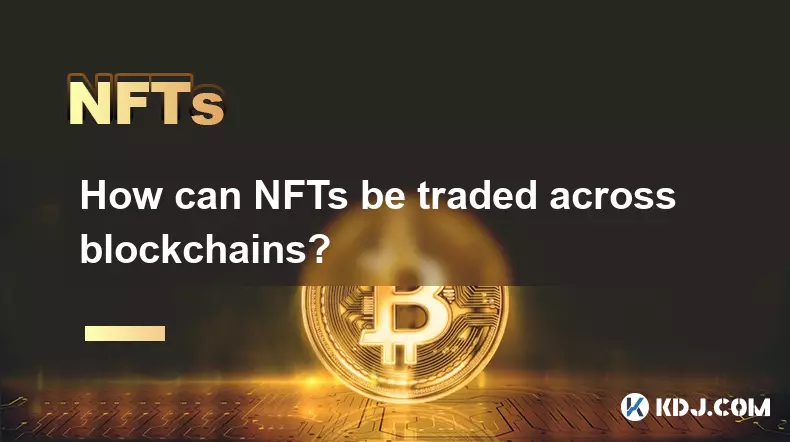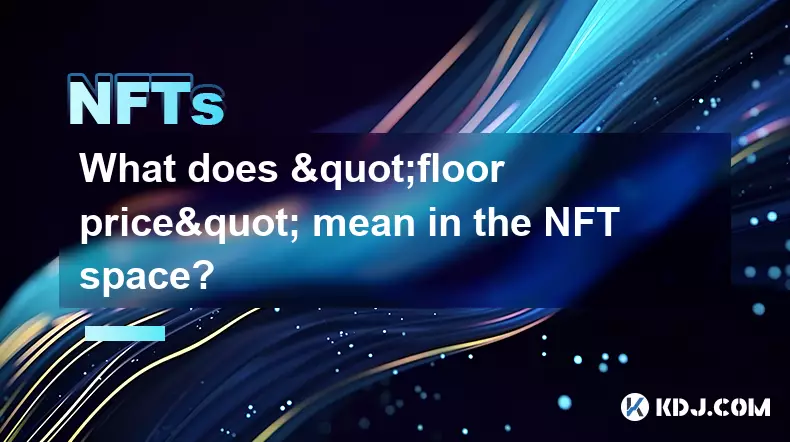-
 bitcoin
bitcoin $109667.069529 USD
-3.03% -
 ethereum
ethereum $3936.685804 USD
-4.07% -
 tether
tether $1.000493 USD
0.01% -
 xrp
xrp $2.771823 USD
-4.74% -
 bnb
bnb $957.805027 USD
-5.34% -
 solana
solana $196.735100 USD
-6.68% -
 usd-coin
usd-coin $0.999727 USD
-0.01% -
 dogecoin
dogecoin $0.227355 USD
-5.12% -
 tron
tron $0.335205 USD
-0.81% -
 cardano
cardano $0.779256 USD
-3.59% -
 ethena-usde
ethena-usde $0.999900 USD
-0.06% -
 hyperliquid
hyperliquid $42.492095 USD
-6.61% -
 chainlink
chainlink $20.501853 USD
-4.34% -
 avalanche
avalanche $28.952606 USD
-11.21% -
 stellar
stellar $0.356038 USD
-3.93%
How can NFTs be traded across blockchains?
Cross-chain NFT trading enables seamless asset movement across blockchains via interoperability protocols, wrapped tokens, and bridges, but faces risks like smart contract vulnerabilities and liquidity fragmentation.
Sep 19, 2025 at 12:00 pm

Understanding Cross-Chain NFT Trading
1. Non-fungible tokens (NFTs) are digital assets that represent ownership of unique items on a blockchain. Originally, NFTs were confined to the blockchain where they were minted, such as Ethereum or Solana. This limitation created silos, preventing seamless interaction between different ecosystems. To overcome this, cross-chain trading mechanisms have emerged, allowing NFTs to move across multiple blockchains while preserving their authenticity and ownership records.
2. The foundation of cross-chain NFT trading lies in interoperability protocols. These protocols act as bridges between distinct blockchain networks. They enable data and asset transfers by verifying transactions on one chain and replicating them on another. For example, a user can transfer an NFT from Ethereum to Polygon using a bridge that locks the original token and mints a wrapped version on the destination chain.
3. Wrapped NFTs play a crucial role in this process. When an NFT is moved from its native chain, it is often locked in a smart contract, and a corresponding representation is created on the target chain. This wrapped version mirrors the properties of the original, including metadata and ownership history. Users can trade these wrapped NFTs within the new ecosystem, knowing they are backed by the original asset.
4. Decentralized exchanges (DEXs) with cross-chain capabilities support NFT trading across networks. Platforms like SushiSwap and PancakeSwap integrate bridge technologies to allow users to swap NFTs between chains directly from their wallets. These DEXs use liquidity pools and oracle systems to maintain price consistency and ensure secure swaps without relying on centralized intermediaries.
5. Security remains a top concern in cross-chain NFT trading. Bridges and wrapping protocols must be audited thoroughly to prevent exploits. High-profile hacks have targeted cross-chain bridges, resulting in significant losses. Therefore, users should verify the credibility of the bridge and check for community trust before initiating any transfer.
Technological Infrastructure Behind Interoperability
1. Blockchain interoperability relies on consensus mechanisms and cryptographic verification. Cross-chain communication protocols such as Cosmos IBC (Inter-Blockchain Communication) and Polkadot’s XCMP (Cross-Consensus Message Passing) facilitate secure messaging between chains. These frameworks ensure that NFT ownership changes on one chain are accurately reflected on another without duplication or fraud.
2. Oracles serve as data relays between blockchains. In the context of NFT trading, oracles validate events such as successful mints, sales, or transfers on one network and trigger corresponding actions on another. Chainlink’s Cross-Chain Interoperability Protocol (CCIP) is an example that enables secure message passing and asset transfers across diverse environments.
3. Smart contracts govern the logic behind cross-chain NFT transactions. They define rules for locking, unlocking, and minting tokens during transfers. Developers must write these contracts with precision to avoid vulnerabilities. Formal verification tools are increasingly used to mathematically prove the correctness of cross-chain smart contract behavior.
4. Layer 2 solutions enhance scalability for cross-chain NFT trading. Networks like Arbitrum and Optimism reduce transaction costs and increase speed, making frequent cross-chain interactions more feasible. By processing transactions off the main chain and settling them later, Layer 2s improve efficiency without compromising security.
5. Multi-chain wallets simplify the user experience. Applications like MetaMask and Trust Wallet now support multiple blockchains, allowing users to manage NFTs across ecosystems from a single interface. These wallets integrate with various bridges and DEXs, enabling seamless navigation through different networks during trading activities.
Challenges and Risks in Cross-Chain NFT Exchanges
1. Fragmentation of liquidity is a persistent issue. Even with cross-chain capabilities, NFT markets remain dispersed across platforms and chains. This fragmentation makes it difficult to establish consistent pricing and discover rare assets. Aggregators like Genie.xyz attempt to solve this by indexing listings from multiple chains into unified marketplaces.
2. Smart contract vulnerabilities pose a major threat to cross-chain NFT trading. Bugs in bridge contracts or incorrect implementation of token standards can lead to irreversible loss of assets. Several high-value NFTs have been stolen due to flaws in third-party interoperability solutions, emphasizing the need for rigorous code audits and transparency.
3. Regulatory uncertainty affects cross-chain operations. Different jurisdictions classify NFTs and blockchain bridges differently, creating compliance challenges. Projects facilitating cross-border NFT transfers must navigate evolving legal landscapes, particularly concerning anti-money laundering (AML) and know-your-customer (KYC) requirements.
4. Gas fees and network congestion impact transaction feasibility. Moving NFTs across chains often involves multiple steps—locking, verification, minting—each requiring gas payments on respective networks. During peak usage, these costs can outweigh the value of the NFT being transferred, discouraging casual traders.
5. Metadata integrity must be preserved across chains. NFTs rely on external data stored via IPFS or centralized servers. If this data becomes inaccessible or altered during a cross-chain transfer, the perceived value and authenticity of the asset may degrade. Ensuring persistent and verifiable metadata storage is essential for maintaining trust.
Frequently Asked Questions
What is a cross-chain NFT bridge?A cross-chain NFT bridge is a protocol that enables the transfer of non-fungible tokens between different blockchain networks. It typically locks the original NFT on the source chain and issues a representative token on the destination chain, maintaining ownership linkage.
Can I lose my NFT when using a bridge?Yes, there is risk involved. If the bridge is compromised, poorly coded, or undergoes a malicious upgrade, users may lose access to their NFTs. Always use well-audited, community-vetted bridges and verify contract addresses before proceeding.
Do all NFT marketplaces support cross-chain trading?No, not all marketplaces offer cross-chain functionality. Some platforms are chain-specific, while others like OpenSea and Blur provide limited multi-chain support. Users must check platform compatibility before attempting inter-chain trades.
Are wrapped NFTs the same as original NFTs?Wrapped NFTs represent the original but exist on a different blockchain. They derive their value from the locked original and can usually be redeemed for it. However, they depend on the security and reliability of the wrapping protocol, which introduces additional risk layers.
Disclaimer:info@kdj.com
The information provided is not trading advice. kdj.com does not assume any responsibility for any investments made based on the information provided in this article. Cryptocurrencies are highly volatile and it is highly recommended that you invest with caution after thorough research!
If you believe that the content used on this website infringes your copyright, please contact us immediately (info@kdj.com) and we will delete it promptly.
- Big Rocking Horse, Coin, and Ice Cream: An Aussie Icon's Sweet Ride
- 2025-09-26 10:45:16
- Pi Network, Price Forecast, and the Meme Market: A New York Minute
- 2025-09-26 10:25:14
- AIXA Miner: Revolutionizing Bitcoin Mining with Cloud Solutions
- 2025-09-26 10:45:16
- Mid-Cap Altcoins: Crypto Buys with Breakout Potential
- 2025-09-26 10:50:01
- BullZilla Presale: Riding the Crypto Wave in September 2025
- 2025-09-26 10:50:01
- Litecoin ETF Buzz, XRP Breakout Dreams, and BlockDAG's Deployment: Crypto's Wild West in '25
- 2025-09-26 10:50:01
Related knowledge

How can I determine the authenticity of an NFT project?
Sep 23,2025 at 05:18pm
Understanding the Project Team and Their Background1. Research the identities of the team members behind the NFT project. Verified social media profil...

What's the difference between NFTs and traditional collectibles?
Sep 19,2025 at 12:55pm
Digital Ownership and Provenance1. NFTs are built on blockchain technology, which ensures transparent and immutable records of ownership. Every transa...

How can NFTs be traded across blockchains?
Sep 19,2025 at 12:00pm
Understanding Cross-Chain NFT Trading1. Non-fungible tokens (NFTs) are digital assets that represent ownership of unique items on a blockchain. Origin...

How is NFT rarity calculated?
Sep 18,2025 at 07:54pm
Understanding NFT Rarity Metrics1. NFT rarity is determined by analyzing the uniqueness of individual traits within a collection. Each NFT typically c...

What does "floor price" mean in the NFT space?
Sep 22,2025 at 06:36am
Floor Price: A Core Metric in the NFT Marketplace1. The term floor price refers to the lowest current asking price for any item within a specific NFT ...

How do NFTs help content creators?
Sep 18,2025 at 08:00am
NFTs Empower Creators with Ownership and Monetization1. NFTs provide content creators with verifiable ownership of their digital works, ensuring authe...

How can I determine the authenticity of an NFT project?
Sep 23,2025 at 05:18pm
Understanding the Project Team and Their Background1. Research the identities of the team members behind the NFT project. Verified social media profil...

What's the difference between NFTs and traditional collectibles?
Sep 19,2025 at 12:55pm
Digital Ownership and Provenance1. NFTs are built on blockchain technology, which ensures transparent and immutable records of ownership. Every transa...

How can NFTs be traded across blockchains?
Sep 19,2025 at 12:00pm
Understanding Cross-Chain NFT Trading1. Non-fungible tokens (NFTs) are digital assets that represent ownership of unique items on a blockchain. Origin...

How is NFT rarity calculated?
Sep 18,2025 at 07:54pm
Understanding NFT Rarity Metrics1. NFT rarity is determined by analyzing the uniqueness of individual traits within a collection. Each NFT typically c...

What does "floor price" mean in the NFT space?
Sep 22,2025 at 06:36am
Floor Price: A Core Metric in the NFT Marketplace1. The term floor price refers to the lowest current asking price for any item within a specific NFT ...

How do NFTs help content creators?
Sep 18,2025 at 08:00am
NFTs Empower Creators with Ownership and Monetization1. NFTs provide content creators with verifiable ownership of their digital works, ensuring authe...
See all articles










































































